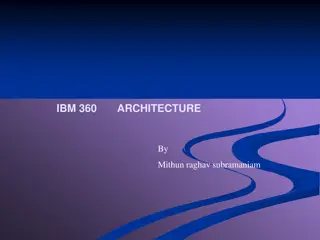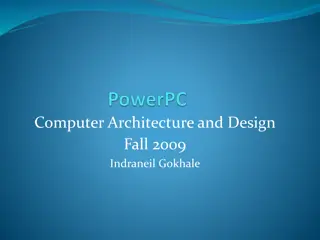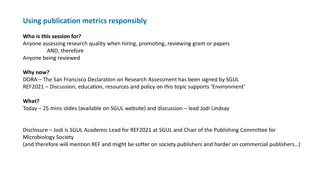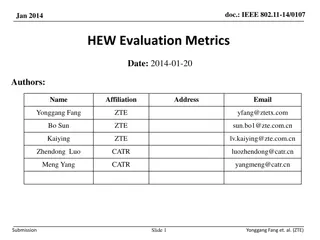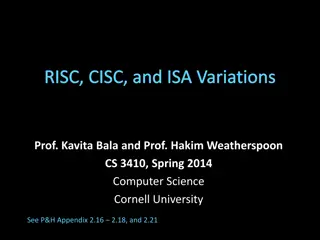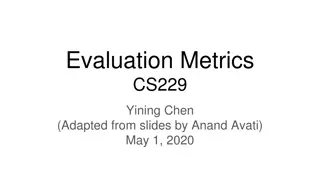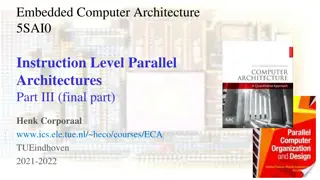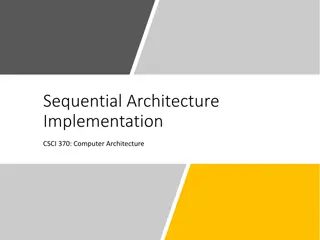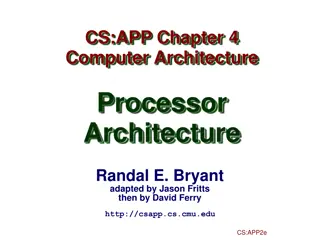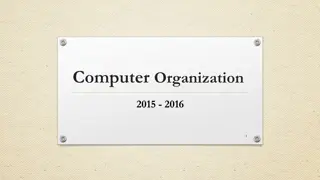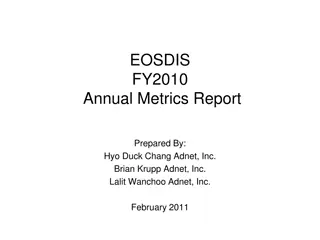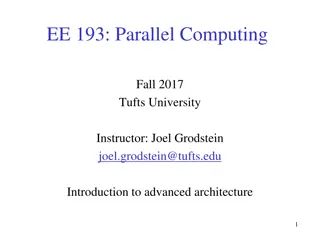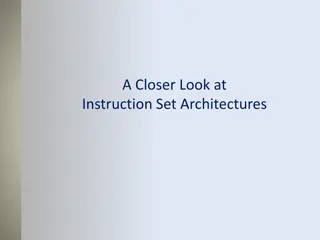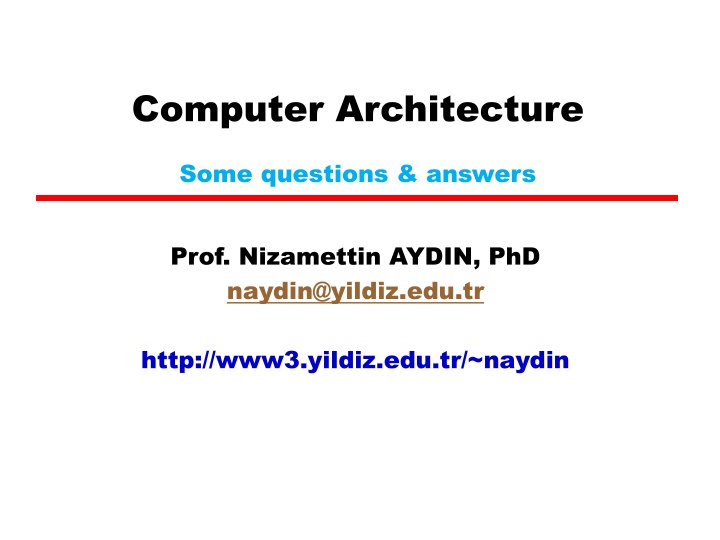
Computer Architecture: Fundamentals, Instruction Set, Performance Metrics
Explore the fundamentals of computer architecture, including computer organization, digital signals, instruction sets, and performance metrics. Dive into topics such as system components, parallelism, Flynn's Taxonomy, and power consumption optimization.
Download Presentation

Please find below an Image/Link to download the presentation.
The content on the website is provided AS IS for your information and personal use only. It may not be sold, licensed, or shared on other websites without obtaining consent from the author. If you encounter any issues during the download, it is possible that the publisher has removed the file from their server.
You are allowed to download the files provided on this website for personal or commercial use, subject to the condition that they are used lawfully. All files are the property of their respective owners.
The content on the website is provided AS IS for your information and personal use only. It may not be sold, licensed, or shared on other websites without obtaining consent from the author.
E N D
Presentation Transcript
Computer Architecture Some questions & answers Prof. Nizamettin AYDIN, PhD naydin@yildiz.edu.tr http://www3.yildiz.edu.tr/~naydin
AcA-00-Introduction What is Computer Organization? What is Computer Architecture? Brief history of computing systems What are the classes of computers? What are the constituents of a computer? What are the constituents of a CPU? What are the constituents of a Control Unit? What are the levels of program code? What is a program? How do you describe The Computer Level Hierarchy?
AcA-01-Fundamentals What is informatics? What is data? What is information? What is knowledge? What is a system? What is an information system? What are to components that implement information system? What is a computing system? What is a digital system? What is a signal?
AcA-01-Fundamentals Compare analog and digital signals Why do we sample a signal? Why do we quantize a signal? Describe continuous, discrete, and digital signals. Describe the process of obtaining digital signals What is sampling theorem? What are the fundamental data types represented in a computing system? Boolean algebra, digital circuit functions
AcA-02-InstructionSet-rev What is an instruction? What is instruction set? What is meant by Instruction Set Architecture? Explain What are the general instruction types in a computing system? What are the elements of an instruction? Classify instruction set in terms of number of operands. What types of operand an instruction can take? What is Big/Little Endian?
AcA-03-Performance List common performance metrics used in a computing system. Describe the Forces on Computer Architecture. What type of parallelisms exist in a computing system? What are the classes of computers? What is Flynn s Taxonomy? Power consumption in a processor How to reduce power consumption? What are the basic performance metrics? What are the measurement tools? What is Amdahl law?
AcA-04-MemoryHierarchy What is Memory Hierarchy? What is the Principle of Locality? What is a Cache? Why a Cache Memory is used? How many cash types exist? What is Main Memory What is Virtual Memory Why a Virtual Memory is used? Classify memory types Differences between SRAM and DRAM? Memory organization Virtual machines
AcA-05-Instruction-Level Parallelism Explain Instruction-Level Parallelism What is pipelining? What is main constraint in paralellism? How many dependences exist? What are data hazards? What techniques exist to avoid dependences What is purpose of Tomasulo s algorithm? Compare the processors interms of pipelining
AcA-06-Data-Level Parallelism What are the classes of parallelizm? Briefly explain Classify computers in terms of the Data- Level Parallelism Brifly describe Vector Architecture How Vector Processors work? Explain with an example Brifly describe Graphics Processing Units Architecture What is heterogen computing system?
AcA-06-Data-Level Parallelism Brifly describe NVIDIA Instruction Set Architecture What are the Challenges for the GPU programmer Compare Graphics Processing Units and vector Architectures Dependences in Loop Level Parallelism How to find dependences in Loop Level Parallelism
Computer Architecture Formulas 1. CPU time = Instruction count Clock cycles per instruction Clock cycle time 2. X is n times faster than Y: n = Execution timeY/ Execution timeX= PerformanceX/ PerformanceY 3. Amdahl s Law: Speedupoverall=Execution timeold 1 = 1 Fractionenhanced +Fractionenhanced Execution timenew Speedupenhance? 4. Energydynamic 1/2 Capacitive load Voltage2 5. Powerdynamic 1/2 Capacitive load Voltage2 Frequency switched 6. Powerstatic Currentstatic Voltage 7. Availability = Mean time to fail / (Mean time to fail + Mean time to repair) 8. Die yield = Wafer yield 1 / (1 + Defects per unit area Die area)N where Wafer yield accounts for wafers that are so bad they need not be tested and N is a parameter called the process-complexity factor, a measure of manufacturing difficulty. N ranges from 11.5 to 15.5 in 2011.
Computer Architecture Formulas 9. Means arithmetic (AM), weighted arithmetic (WAM), and geometric (GM): ? ? ? AM =1 ? ? ?=1 Time?, WAM = Weight? Time?, GM = Time? ?=1 ?=1 where Timeiis the execution time for the ith program of a total of n in the workload, Weightiis the weighting of the ith program in the workload. 10. Average memory-access time = Hit time + Miss rate Miss penalty 11. Misses per instruction = Miss rate Memory access per instruction 12. Cache index size: 2index= Cache size /(Block size Set associativity) Total Faciliy Power IT Equipment Power 13. ????? ??????????? ????????????? (???) of a Warehouse Scale Computer =
Rules of Thumb 1. Amdahl/Case Rule: A balanced computer system needs about 1 MB of main memory capacity and 1 megabit per second of I/O bandwidth per MIPS of CPU performance. 2. 90/10 Locality Rule: A program executes about 90% of its instructions in 10% of its code. 3. Bandwidth Rule: Bandwidth grows by at least the square of the improvement in latency.
Rules of Thumb 4. 2:1 Cache Rule: The miss rate of a direct-mapped cache of size N is about the same as a two-way set- associative cache of size N/2. 5. Dependability Rule: Design with no single point of failure. 6. Watt-Year Rule: The fully burdened cost of a Watt per year in a Warehouse Scale Computer in North America in 2011, including the cost of amortizing the power and cooling infrastructure, is about $2.



